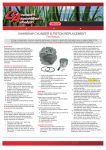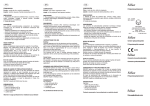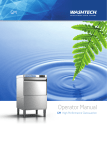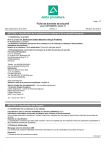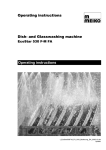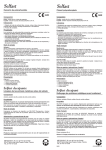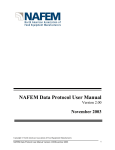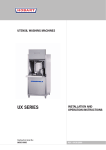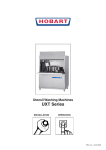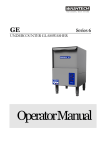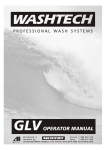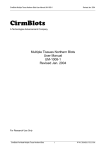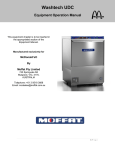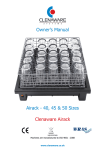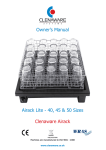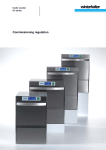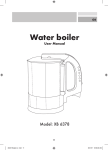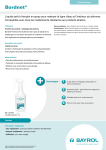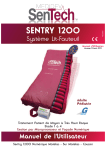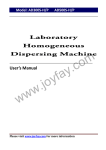Download CHEMICAL GUIDE
Transcript
CHEMICAL GUIDE efficient – reliable – innovative 1. YOUR PROFFICIENT DISHWASHING PARTNER CHEMICAL GUIDE efficient – reliable – innovative 1.1 SPECIALISTS IN DISHWASHING Hobart is a global leader in the field of commercial warewashing technology. Hobart products stand for top quality and reliability and have been developed in close cooperation with customers. Thousands of Hobart machines are used by satisfied customers all over the world who rely on the „Made in Germany“ quality mark. All HOBART machines – from large flighttype dishwashers to compact glasswashers – meet the same high quality standards. First impressions are important, and there is nothing more inviting in a restaurant than clean, sparkling crockery and glassware. This chemical guide contains all the information, tips and tricks you need to achieve brilliant cleaning results – for satisfied customers! 2. WHY USE HOBART DETERGENTS AND RINSE AIDS? CHEMICAL GUIDE efficient – reliable – innovative HOBART PRODUCTS OFFER A RANGE OF ADVANTAGES • Excellent cleaning results thanks to quality components • Product formulations are tailor-made for HOBART dishwashers • Clearly labelled and colour-coded containers to prevent confusion • Excellent reliability • Easy handling and dosing thanks to an integrated dosing system for liquid products • Clearly structured product range for all applications WHY USE HOBART DETERGENTS AND RINSE AIDS? 2.1 3. WHAT ARE THE KEY FACTORS FOR BRILLIANT DISHWASHING RESULTS? efficient – reliable – innovative 3.1 A CIRCLE THAT EXPLAINS THE COMPLETE CLEANING CYCLE! The Sinner circle developed by the chemist Dr. Herbert Sinner illustrates the four key components for the hygienic cleaning of crockery, glassware and cutlery, namely temperature, time, chemical action and mechanical action. For the washing of glassware, the quality of the water is another important factor. These factors are arranged in a circle. If one factor is reduced, the loss must be compensated for by increasing one or more other factors. For instance, if you wish to reduce the amount of chemicals used in the process, you must increase the temperature. This is, of course, only possible within certain limits, as excessively high temperature would cause the glass to crack. WHAT ARE THE KEY FACTORS FOR BRILLIANT DISHWASHING RESULTS? SEGMENTE CHEMICAL GUIDE 3.1 A CIRCLE THAT EXPLAINS THE COMPLETE CLEANING CYCLE! CLEANING FACTORS TEMPERATURE CHEMICAL ACTION CLEANING FACTORS IN HOBART DISHWASHERS Temperature MECHANICAL ACTION TIME MECHANICAL ACTION CHEMICAL ACTION TIME efficient – reliable – innovative 3.2 PERFECT CHEMISTRY! Sparkling, hygienically cleaned washware can only be achieved by using the correct amounts of carefully selected detergents and rinse aids. Why? Depending on the washware for which they are formulated, detergents and rinse agents contain different ingredients. Chemicals for glassware washing must, for example, protect the surface and the decorative effect while ensuring hygienic cleaning. Perfect hygienic results can only be achieved by choosing the right detergent and the right rinse aid. WHAT ARE THE KEY FACTORS FOR BRILLIANT DISHWASHING RESULTS? SEGMENTE CHEMICAL GUIDE efficient – reliable – innovative 3.3 CORRECT TEMPERATURE RANGE! Glasswashing: The washing temperature should be around 55°C, while the rinsing temperature should be between approx. 60 and 70°C. Dishwashing: The washing temperature should be around 60 to 65°C, while the rinsing temperature should be between approx. 80 and 85°C. Why? The higher the temperature, the more effective the chemical cleaning action. If the water temperature is too low, dirt might remain on the washware and germs might survive. However, excessively high temperatures can result in glass corrosion and glass breakage. High temperatures shorten the service life of decorative glassware. WHAT ARE THE KEY FACTORS FOR BRILLIANT DISHWASHING RESULTS? SEGMENTE CHEMICAL GUIDE efficient – reliable – innovative 3.4 ADEQUATE WASHING TIME! In the catering business, time is a scarce commodity. During busy periods, every minute counts. If all the cleaning factors are optimised, commercial dishwashers can process a full basket within about 60 seconds! Why? HOBART dishwashers optimise the Sinner circle cleaning factors of temperature, chemical action and mechanical action in such a way that the time factor can be reduced to a minimum. WHAT ARE THE KEY FACTORS FOR BRILLIANT DISHWASHING RESULTS? SEGMENTE CHEMICAL GUIDE efficient – reliable – innovative 3.5 EFFECTIVE MECHANICAL ACTION! Apart from the temperature, chemical action, time, mechanical action and water pressure have a huge effect on the cleaning result. Why? Wash water at the correct pressure removes dirt from the washware, leaving behind a perfectly rinsed surface. Dried food scraps and milk froth residue are effectively dissolved and washed away by water sprayed at the correct pressure. WHAT ARE THE KEY FACTORS FOR BRILLIANT DISHWASHING RESULTS? CHEMICAL GUIDE 3.6 GOOD WATER QUALITY! The cleaning result heavily depends on the quality of the water used in the machine. Why? Every drop of water contains many different chemicals, including minerals and salts. Other important water quality factors are the carbonate hardness and the non-carbonate hardness. To achieve spotlessly clean washware, water must drip off without leaving behind any mineral or salt residue. The mineral content of water, which includes salts, is measured in μS/cm. Ideally, rinsing water should be treated to reduce the total mineral content or even eliminate all minerals. This is done by using a partial or full desalination cartridge, which ensures spotless glassware and cutlery. efficient – reliable – innovative HOBART recommendation • For spotless glassware, the total salt content of water should be around 100 μS/cm. Depending on the raw water composition, this can be achieved by treatment in a partial or full desalination cartridge. • Water softening systems are designed to prevent limescale deposits. They primarily protect the machine components such as heating rods and wash arms. As water softening systems do not reduce the total mineral content of the water, they cannot effectively prevent water spots on dry glassware and crockery. WHAT ARE THE KEY FACTORS FOR BRILLIANT DISHWASHING RESULTS? SEGMENTE CHEMICAL GUIDE 4. HOW DO CLEANING AGENTS WORK? CHEMICAL GUIDE efficient – reliable – innovative FUNCTIONS OF DETERGENTS • Emulsification: grease and fat is emulsified and removed from the washware • Dispersion: solid and insoluble residue is removed from the washware • Hygiene treatment: disinfectant agents such as chlorine, active oxygen, etc. • Protection of washware: special care ingredients designed to protect the washware • Water softening: prevention of deposits on the washware or on machine parts (only effective up to a certain hardness grade) • Wetting of washware for improved water distribution • Capillarity: reduction of surface tension so that water can enter all recesses and cavities HOW DO CLEANING AGENTS WORK? 4.1 4.2 FUNCTIONS OF RINSE AGENTS • Wetting of cleaned washware for effective rinsing • Reduction of water surface tension: reduction of interfacial tension • Accelerated washware drying CHEMICAL GUIDE efficient – reliable – innovative EFFECTS OF INDIVIDUAL ACTIVE INGREDIENTS Detergents contain a number of active agents: main ingredients and their effects: • Alkaline agents: swelling and removal of proteins, grease and starch; increase of pH • Bleaching agents: destruction of colorants and disinfection • Enzymes: removal of grease, protein and starch particles • Phosphates, citrates, polycarboxylates: suspension of dirt particles • Tensides: reduction of interfacial tension, for improved dissolution of grease and dirt particles • (Citric) acid: prevention of limescale deposits; removal of rust particles; reduction of pH; biodegradable HOW DO CLEANING AGENTS WORK? 4.3 5. SAFE HANDLING OF DISHWASHER CHEMICALS CHEMICAL GUIDE efficient – reliable – innovative COMPLIANCE WITH HOBART RECOMMENDATIONS • HOBART detergents and rinse aids are carefully formulated for best compatibility and effectiveness. • Observe the dosing instructions. If the rinse aid concentration is too low, droplets and residual limescale streaks remain on the cleaned washware. The goods are therefore not perfectly clean and might not last as long as when rinsed properly. Excessive rinse aid in the cycle results in streaks on the washware, pollutes the water and is not economical. • The correct dosing quantities should be determined by a specialist technician upon installation and commissioning of the machine. • Use only detergents and rinse aids made for commercial dishwashers. • Acidic detergents or products containing chlorine might cause damage to the decorative effect and turbidity. • When changing detergent or rinse aid, observe the instructions in the user manual to prevent damage to the dosing system. SAFE HANDLING OF DISHWASHER CHEMICALS 5.1 5.2 PREVENTION OF EXCESSIVE CHEMICALS CONSUMPTION The cleaning results are determined by factors that are outside the machine. Under unfavourable conditions, these factors can lead to increased consumption of detergent and rinse aid. Such problems can occur in the following situations: • Insufficient manual removal of food scraps • Food on plates has been allowed to dry • Short contact times combined with very dirty washware • Dosing quantity too high or too low • Extremely hard water in dishwasher Preventing such problems results in reduced detergent consumption, which helps protect the environment and saves you money! CHEMICAL GUIDE efficient – reliable – innovative SAFE AND CAREFUL HANDLING OF CHEMICALS • Always wear protective goggles and gloves. • Should small amounts of alkaline or acidic substances come into skin contact, immediately rinse the affected area with plenty of water. • Remove soiled clothing to prevent skin irritation. • In the event of skin or eye contact, immediately consult a doctor. Correct storage • Store in properly sealed, upright original containers. • Store in a cool and dry room. • Protect against direct sunlight, frost and heat. • Do not store together with incompatible substances, food or beverages. SAFE HANDLING OF DISHWASHER CHEMICALS 5.3 6. POOR CLEANING RESULTS – CAUSES AND REMEDIES CHEMICAL GUIDE efficient – reliable – innovative TROUBLESHOOTING PROBLEM Washware not properly cleaned POSSIBLE CAUSE REMEDY Excessive dirt in machine Improve manual plate clearing procedure, clean the filters in the machine Wash arm/rinse arm fails to rotate; the nozzles are blocked Remove wash arm/rinse arm and clean Insufficient detergent and/or rinse agent Increase chemical dosage Insufficient or no detergent and/or rinse agent Canister empty; replace canister Shelf life exceeded Change product Starch residue, discolouration Chosen product not suitable for current cleaning task; change product and/or clean washware by hand Washware shows streaks and smells of detergent; poor cleaning performance, alkaline solution is not neutralised Detergent and rinsing aid canisters are connected the wrong way round: detergent is added to the boiler, while rinse aid is added at the washing tank Check dosing hoses are correctly installed in the right bottles Flush boiler and dosing hoses with water Strong smell of chlorine Chlorine detergent instead of chlorine-free detergent used; dosing quantity too high Adjust dosage, use chlorine-free detergent Rinse aid concentration too low Adjust dosage Washware fails to dry; water droplets and streaks on washware; no sheen POOR CLEANING RESULTS – CAUSES AND REMEDIES 6.1 CHEMICAL GUIDE efficient – reliable – innovative TROUBLESHOOTING PROBLEM POSSIBLE CAUSE REMEDY Plastic parts fail to dry Rinse aid concentration too low Adjust dosage Streaks, rainbow colours, clouds and burst bubble marks on washware Rinse aid concentration too high Adjust dosage Hoses were not rinsed with water before installing a new product Thoroughly rinse dosing hoses with water Machine is operated with excessively hard water Use water softener Dosing quantity too high Adjust dosage/reduce dosing time pH in water tank increases gradually (crystals in detergent) Product shelf life has been exceeded, or product canister has been left open for a prolonged period of time; keep canisters tightly closed Chemicals not suitable for actual hardness of water Change product Incompatibility with chemicals; glass corrosion, damage to décor, etc. Change detergent Aluminium cleaner has been used as immersion cleaner Use aluminium cleaner only in machine and not as an immersion cleaner Dosing quantity too high Adjust dosage/reduce dosing time Crystals in dosing hose, no addition of detergent/rinse aid Limescale Chemicals consumption too high Discoloured washware Discoloured aluminium parts POOR CLEANING RESULTS – CAUSES AND REMEDIES 6.1 WE ARE ALWAYS THERE FOR YOU. CHEMICAL GUIDE efficient – reliable – innovative • The correct dishwashing chemicals • Proper water pre-treatment The HOBART hygiene products of the HYLINE hygiene range are available from your specialist dealer. • The correct basket selection to match your washware For further information, see www.hobart-export.com. • User training on your dishwasher HYLINE CHEMICAL SALES WE ARE ALWAYS THERE FOR YOU HOBART OFFERS ITS CUSTOMERS COMPETENT SPECIALIST SUPPORT FOR food preparation waste treatment HOBART GMBH Robert-Bosch-Straße 17 77656 Offenburg Phone +49(0)781.600-28 20 service Fax +49(0)781.600-28 19 e-Mail: [email protected] Internet: www.hobart-export.com efficient – reliable – innovative Member of the ITW Food Equipment Group Europe The information in this brochure was valid at the date of printing (02/2012). All information is subject to change without prior notice. cooking PR-0212-729-K-e warewashing
































